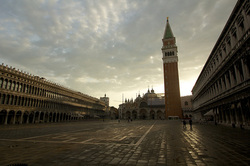 When we live in a home or building, we don't think about a good many factors that may or may not be included into the design of space. Over the years, the longer we live in a space, we look at a home as merely a place where we keep our things, eat, sleep, bathe and repeat. Whenever we give visitors directions in a city, we use certain elements to help them navigate around. "When you get to the clock tower, you want to make a right and keep going until you see a short pink building on a corner selling candies. You'll usually see a line outside so make a left there and keep driving until you see the park on the right." We do the same thing in a new house. When you have a friend over, you invariably get asked, "Hey, where's your bathroom?" and you begin a line of direction that's similar to how you give directions in a city. "Go down three doors and when you see the dresser in the hall covered in photographs, make a right and then it's the first door on your left." When you learn to live in a city, you learn to navigate it and likewise your home. When you learn your home by heart, you can easily tell anyone where to find anything. Urban planner Kevin Lynch wrote The Image of the City in 1960 talking about three cities in particular: Los Angeles, CA, Jersey City, New Jersey and Boston, Massachusetts. Los Angeles being the modern city, Jersey City being an edge city and Boston developing from the original basis of an old world city. The five things that help define a city are Paths, Districts, Nodes, Edges and Landmarks. Now, in the context of a city, we can understand how these five things behave, but ask yourself: "How does this even begin to apply to the design of my house and home?" So we approach each one of these to the house and home. 1. Paths - In the context of the city environment, paths are what define how we get around. From a huge arterial road to a belted green way, we communicate with the city by experiencing it on the most basic level: on foot. We can look at the home in the same way, that we cannot communicate between rooms without having to utilize paths that we create and establish through partitions and furniture. 2. Districts - We can recognize this word instantly and associate it with a neighborhood that's distinctive in it's culture, financial status, ethnic composition and architecture sometimes even. Chinatown has its distinctive style, Harlem is known for its brownstones and Lakewood for its tract homes. While on the individual home scale and level this might be a harder thing to associate, we create distinctive spaces in design. The cooking and eating area might have a theme, so might the bedroom as well as the office. It is a very rare occurrence that we ever visit someone's home and cannot find any distinctions between areas of activity. 3. Nodes - Think of a train station along a commuter line. Now, intersect where that station is with a light rail line moving perpendicularly. We can take it further, imagine radiating from this train station, a multitude of bus lines crossing it. Just one more step, let's add shops and higher density housing around it. We've just created a node. The node in the home isn't as obvious since it might not be a part of the formal architecture. We understand it as the television set we all group around, the dining table we all sit at to eat with one another, the kitchen where everyone migrates to whenever someone is cooking. 4. Edges - How we define spaces are by edges. When you enter chinatown, it becomes very obvious that we've entered a new space. From the lion gate on Grant Avenue, you've obviously entered a distinctive space from the shopping district of Union Square in San Francisco. While walls end up defining the edges of our room, an open floor plan can create little spaces by the way we arrange furniture and place little amenities. The back of a couch can serve this pretty nicely to create a little lounge area near a fireplace.  5. Landmarks - We know what a landmark is. It's something distinctive that draws our bodies over towards it. From the impressive campanile that marks the intersection of the two squares of St. Mark's in Venice to a humble fountain in someone's backyard, it's these features that draw the eye and the ear over to it. But we want to move the idea of landmark beyond that of just a television set that stimulates the eyes and ears. In the house, create a visually appetizing space: A curving staircase, a swimming pool, a fire pit, you name it. In many ways, we can learn as much from our homes as we can from the city landscape that we situate ourselves in. Look at it closer, examine it, find what you love and how you can incorporate it into your own personal space. You can make the change today into something that will keep people talking for a lifetime.
0 Comments
Leave a Reply. |
AuthorHere at Biggs Group, we constantly have a lot of projects going on, and design ideas that can take a design to the next level. Here is a sampling of some of what drives us. Archives
August 2015
Categories |
Photos used under Creative Commons from Bob Jenkin, City of Boston Archives, REVIVALthedigest, StartAgain

 RSS Feed
RSS Feed
